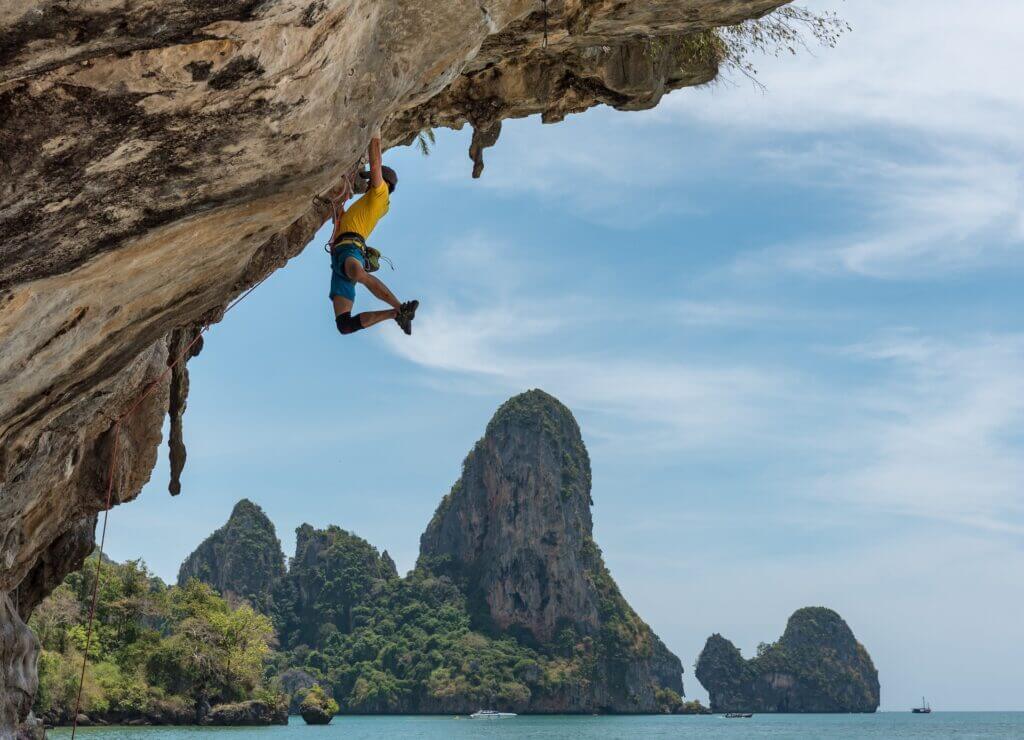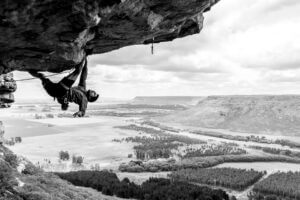Rock climbing is a sport where participants climb up, across, or down rock formations. The goal of the sport is to reach the top of the formation, whether it be an alpine peak or a 13-foot boulder. Usually, rock climbers use a pre-established route and rely on strength, balance, endurance, and technique to reach the top.
Due to the wide variety of rock found across the globe, climbing has developed into different disciplines, each with its own sub-disciplines. All of which come with their own cultural history and modern climbing ethics and style.
Ever wondered– “What is rock climbing?” If you have, then you have come to the right place. Keep reading to learn about some of the most popular forms of rock climbing.
Types of Climbing
Various disciplines fall under the umbrella of the sport of rock climbing. The different disciplines of rock climbing emerged as the sport developed, technology changed, and new terrain was opened up.
Aid Climbing
One of the oldest disciplines of rock climbing, aid climbing is a gear-dependent form of rock climbing in which a climber stands on and pulls themself up the rock wall using devices, such as raiders or stirrups, attached to the protection they place in the rock.
Like other forms of climbing, the leader ties into a rope and is on belay with a partner. However, they are using equipment to aid their ascent up the wall. This varies drastically from a second discipline of climbing called free climbing.
Free Climbing
A form of rock climbing that does not rely on equipment to aid the ascent. Instead, free climbing uses gear only for protection and not upward progress. The climber makes progress up the wall using only their hands and feet.
Today, free climbing is the most popular discipline. It is subdivided into bouldering, traditional climbing, and sport climbing.
| Types of Free Climbing | |||
| Bouldering | Traditional or “Trad” Climbing | Sport Climbing | |
| Description of the Discipline | A form of free climbing performed on small rock formations or boulders, and without the use of ropes, belayers, or harnesses | A form of free climbing where the leader climbs with a rope in single or multi-pitch terrain without bolts | A form of free climbing where the leader climbs with a rope in single or multi-pitch terrain with protection bolts |
| Description of the Protection Used | The only form of protection in bouldering is crash pads placed on the ground beneath the boulder to prevent injuries from falling | The leader places removable protection pieces into cracks in the rock to protect against a fall | The leader clips quickdraws into fixed protection bolts and anchors drilled into the rock to protect against a fall |
| Description of How the Route is Cleaned | At the end of the day, the pads are removed, and nothing is left behind | The belayer, or second climber, removes the protection pieces, leaving nothing behind | The belayer, or second climber, removes the quickdraws from the bolts, and the bolts and anchors are left permanently |
Free Climbing vs. Free Soloing
It is a common misconception to assimilate free climbing with free soloing. The two are very different.
As I mentioned above, free climbers use ropes, belayers, and trad gear or bolts (sometimes both) to protect themselves in the event of a fall. However, they do not use any aid gear. They ascend the all using only their hands and feet.
On the other hand, free soloing does not use ropes, belayers, or protection of any kind. Yes, free soloing climbers are free climbing because they are not using gear to aid their ascent. However, there do not use protection. Therefore, consequences can be catastrophic in the event of a fall.

Climbing Style
As rock climbing has developed, climbers decided that getting to the top of a route or boulder is not enough. The style in which you make the ascent also matters.
Modern climbing has prioritized free ascents (vs. aid ascents), and getting to the top of the climb in as few attempts as possible, ideally on the first go.
- On-sighting- to successfully onsight, you must ascend the route without falling or using aid equipment on your first attempt and without prior knowledge of the climb.
- Flashing- to flash a climb means to cleanly ascend the route on your first try using previous information you gathered from inspecting the climb or from other climbers.
- Redpointing- a redpoint is when you successfully free climb a route from the ground up without falling after having previously tried the climb.
- Pinkpointing- to successfully pinkpoint a route, you must free climb from the ground up without falling using pre-placed protection, such as trad gear or quickdraws.
Climbing Techniques
Different rock types necessitate different climbing techniques. And sometimes, you must use a mixture of climbing techniques to climb a rock face or boulder successfully. Below I offer a quick overview of four common climbing techniques.
Crack Climbing
Predominately practiced in the trad climbing discipline, crack climbing is when you strategically jam your toes, feet, fingers, and hands into cracks in the rock to make upward progress. The body part you jam and the technique you use depend on the crack size. There are no face holds on pure crack climbs, and the crack climbing technique is mandatory.
Face Climbing
Predominately practiced in the sport climbing discipline, face climbing is when a climber ascends a rock face using three-dimensional features in the rock such as edges, pockets, flakes, tufas, pinches, and slopers. Face climbing is usually performed on a steep vertical wall. However, you can utilize face climbing techniques on overhanging terrain also.
Slab Climbing
Also known as friction climbing, slab climbing occurs on a rock face that is less than ninety degrees or less than vertical. Slab climbing prioritizes footwork and balance over brute strength. Hand and foot holds are often tiny, if not “nonexistent,” thereby demanding the climber to rely on the friction between their finger, hands, and climbing shoes to ascend.
Simultaneous Climbing
Also known as simul-climbing, simultaneous climbing is when two climbers climb simultaneously without stopping to build anchors or formally belay one another. The leader places protection as they advance upwards that the second climber collects. Simul climbing is the preferred technique for risky speed ascents.
Grading Systems
Over time, grading systems were developed to categorize rock climbs by their difficulty. Although they are helpful, you should take grading systems with a grain of salt because they vary largely from place to place.
In other words, grading systems are meant to function as guidelines.
The Yosemite Decimal System is used in the United States to rate technical rock climbs from 5.0 to 5.15. However, for bouldering, the Vermin- or V-scale is used to grade boulders. And throughout the globe, other grading scales have been developed by region and sometimes by country. For example, Australian climbers use their own unique grading system.


